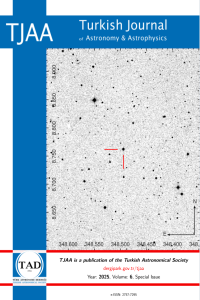Öz
Novaların patlama sonrasında oluşan zarfları çeşitli dar süzgeçlerle gözlenerek araştırılmaktadır. Bu çalışmada, genişleme paralaksı ile novaların zarfları ortaya çıkartılmakta, açısal büyüklükleri belirlenmekte ve nihayetinde mutlak parlaklıkları dolayısıyla uzaklıkları tespit edilmektedir. Görüntüleme yöntemi kullanılarak, RTT150 TFOSC kamerasının 11.1x11.1‘ görüş alanına giren nova ve komşu yıldızların astronomik görüş (seeing veya PSF) değerleri ölçülmüştür. Bu amaçla OIII (λ500.7 nm), Hα (λλ656.39 ve 656.92 nm) ve SII (λ674.98 nm) dar bant filtrelerinde (FWHM olarak sırasıyla 5.6, 2.0, 5.0 ve 6.4 nm) uzun poz (1800 ve 3600 saniye) verilerek alınmış görüntüler kullanılmıştır. Burada belirtilen dar bantların Hα, OIII ve SII olarak seçilmesi aranan nova kabuğunun içeriği ile ilgilidir. Yaygın kaynak olan nova kabuklarında hidrojen ve oksijen bolluğu yüksek kükürtün ise zayıf olmaktadır. Çalışmanın bu aşamasında 13 adet novanın gözlem verileri bilgisi ve üzerinde nova kabuğu olup olmadığının tespitine ilişkin sonuçlar verilmiştir. Buna göre, nova V1831 Aql ve V962 Cep’te kabuk henüz ölçüm alınabilecek büyüklüğe genişlememiştir. Nova V611 Sct’un çok zayıf bir kabuk yapısı görülmüştür. V1974 Cyg, V2659 Cyg, V339 Del, V392 Per, V1112 Per ve V612 Sct’ta belirgin ve ölçüm yapılabilecek nova kabukları belirlenmiştir. Ayrıca, DQ Her’in çok genişlemiş kabuğu yıldızlararası ortama katılma sürecindedir. V1112 Per’in dar band gözlemine ek olarak tayfı da alınmıştır. Kabuğunun Hα ve OIII dar band görüntülerindeki parlaklık farkı tayfındaki Hα ile OIII spektrel çizgilerinin şiddetleri arasındaki farkla ilişkili olduğu görülmüştür. RW UMi’nin örnek bir güncel kabuk çapı hesaplaması da gösterilmiştir.
Anahtar Kelimeler
nova nova shell narrow band imaging observation expansion parallax
Etik Beyan
Etik kurallara uyduğumuzu beyan ederiz.
Destekleyen Kurum
Türkiye Ulusal Gözlemevleri TUG
Teşekkür
Türkiye Ulusal Gözlemevleri TUG 22BRTT150-1974 numaralı "Genişleme Paralaksı ile Nova Zarfları Araştırması" başlıklı proje tarafından desteklenmiştir.
Kaynakça
- Cohen, J.G., ApJ 292 (1985) 90–103
- Esenoğlu, H.H., Novaların tayfsal ve fotometrik analizi: Yeni bir sınıflama metodu (Danışman: Prof.Dr. M.T.Özkan), YÖK Tez Merkezi 56089 (1996)
- Esenoglu, H., Dissertation, PASP 109 (1997) 1285—1285
- Esenoglu, H.H., Workshop on Mechanisms of Cataclysmic Variable (Ed. M.Altan), Anadolu Ü. Yayınları No:3170 ve Fen Fakültesi Yayınları no:38, ISBN:978-975-06-1797-3 (2015)
- Esenoglu, H.H., Saygac A.T., Bianchini A., Retter A., Ozkan M.T., Altan M., AA 364 (2000) 191—198
Öz
The post-outburst shells of novae are being studied by observing them using a range of narrowband filters. In this study, we employ the expansion parallax method to investigate the shells of novae, measure their angular sizes, and ultimately determine their absolute luminosities, enabling us to calculate their distances. Using the imaging method, the seeing (PSF) values of the nova and nearby stars within the 11.1‘x11.1‘ field of view of the RTT150 TFOSC camera were measured. To achieve this, long-exposure images (1800 and 3600 seconds) were taken using narrowband filters centered on OIII (λ500.7 nm), Hα (λλ656.39 ve 656.92 nm), and SII (λ674.98 nm), with respective FWHMs of 5.6 nm, 2.0 nm, 5.0 nm, and 6.4 nm. The selection of the narrowband filters Hα, OIII, and SII is directly related to the chemical composition and emission characteristics of the nova shell. Nova shells typically exhibit high abundances of hydrogen and oxygen, while sulfur is present in lower quantities. At this stage of the study, observational data for 13 novae are presented, along with the results indicating whether a nova shell is detected around each of them. Accordingly, in the cases of nova V1831 Aql and V962 Cep, the shells have not yet expanded to a size sufficient for measurable observations. Nova V611 Sct exhibits a very faint shell structure. Prominent and measurable nova shells were detected around V1974 Cyg, V2659 Cyg, V339 Del, V392 Per, V1112 Per, and V612 Sct. In addition, the significantly expanded shell of DQ Her is in the process of merging with the interstellar medium. In addition to the narrowband observations of V1112 Per, a spectrum was also obtained. The brightness difference observed in the Hα and OIII narrowband images of the shell is directly related to the variation in the intensities of the Hα and OIII spectral lines in the spectrum. An example of the current shell diameter calculation for RW UMi is also provided.
Anahtar Kelimeler
nova nova shell narrow band imaging observation expansion parallax
Kaynakça
- Cohen, J.G., ApJ 292 (1985) 90–103
- Esenoğlu, H.H., Novaların tayfsal ve fotometrik analizi: Yeni bir sınıflama metodu (Danışman: Prof.Dr. M.T.Özkan), YÖK Tez Merkezi 56089 (1996)
- Esenoglu, H., Dissertation, PASP 109 (1997) 1285—1285
- Esenoglu, H.H., Workshop on Mechanisms of Cataclysmic Variable (Ed. M.Altan), Anadolu Ü. Yayınları No:3170 ve Fen Fakültesi Yayınları no:38, ISBN:978-975-06-1797-3 (2015)
- Esenoglu, H.H., Saygac A.T., Bianchini A., Retter A., Ozkan M.T., Altan M., AA 364 (2000) 191—198
Ayrıntılar
| Birincil Dil | Türkçe |
|---|---|
| Konular | Astronomik Bilimler (Diğer) |
| Bölüm | Bildiri |
| Yazarlar | |
| Erken Görünüm Tarihi | 22 Haziran 2025 |
| Yayımlanma Tarihi | 1 Temmuz 2025 |
| Gönderilme Tarihi | 8 Aralık 2024 |
| Kabul Tarihi | 24 Mart 2025 |
| Yayımlandığı Sayı | Yıl 2025 Cilt: 6 Sayı: Special Issue: UAK2024 Proceedings of the 23rd National Astronomy Congress |
TJAA, Türk Astronomi Derneğinin (TAD) bir yayınıdır.


